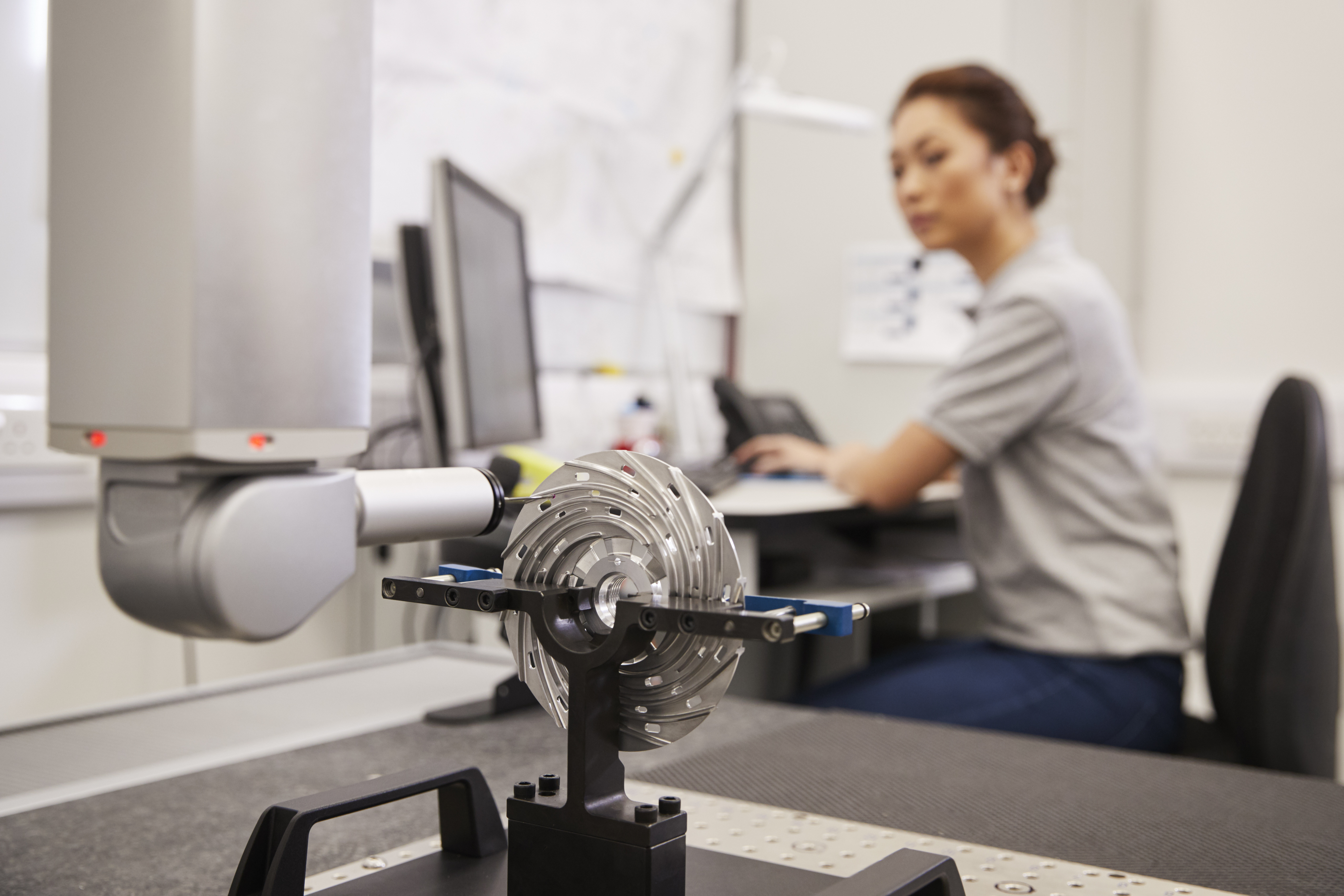How Does a Handheld CMM Scanner Work for Industrial Quality Inspection?
Handheld CMM scanners now have more advanced capabilities than when they first emerged on the market, making them a reliable tool for working in industrial quality inspection. Their mobility supports modern production processes that require a precision quality control system to be brought directly to the produced parts.
Metrology-grade handheld CMM scanners are also very accurate, which is critical for modern industrial manufacturing. For example, inspection requirements for the complex parts often produced in industrial manufacturing consist of stricter tolerances, making higher accuracy standards essential. Since efficiency and speed are also important factors to consider when incorporating quality inspection into your workflow, handheld CMM scanners are among the best choices for industrial quality inspection.
 Traditionally, coordinate measuring machines (CMMs) are a common choice for accurately measuring parts for quality control. Traditional CMMs reliably perform accurate dimensional analysis on parts produced in the first production run; however, these stationary measurement systems are not ideal for situations in which you would need to transport the part to the machine or bring the machine to the part. For these circumstances and any others requiring you to inspect items on the spot, you need a quick, portable solution.
Traditionally, coordinate measuring machines (CMMs) are a common choice for accurately measuring parts for quality control. Traditional CMMs reliably perform accurate dimensional analysis on parts produced in the first production run; however, these stationary measurement systems are not ideal for situations in which you would need to transport the part to the machine or bring the machine to the part. For these circumstances and any others requiring you to inspect items on the spot, you need a quick, portable solution.
A handheld CMM scanner is fast, flexible, and economical. You can scan tight spaces and measure parts directly in the production facility without worrying about moving the product to the metrology department. Read on to learn more about handheld portable CMM scanners and how you can use them for quality control inspection.
What is a Handheld CMM Scanner?
A handheld CMM scanner is a measurement solution you can move to any part of the factory floor by hand to perform a part's quick, real-time dimensional analysis.
Portable CMM scanners come in both contact and non-contact variations. A contact portable CMM machine consists of a touch probe that detects surface geometry by pressing on a location and collecting data points from the surface that get sent back to the software. A non-contact portable CMM, often called a 3D scanner, laser (in laser trackers) or light (in optical CMM), strikes the object's surface, and the portable CMM detects the change in laser or light and sends it to the software in the form of XYZ coordinate points.
Common handheld portable CMM scanners include laser trackers (non-contact), articulated arm CMMs (contact or non-contact), and optical CMMs (non-contact).
How is Quality Measured Using a Handheld CMM Scanner?
A handheld CMM scanner helps you measure quality by performing dimensional analysis on the required part and comparing the acquired data against the desired parameters.
Here's the step-by-step process for inspecting a component using a portable CMM machine:
1. Initial setup
The initial setup depends on your specific project. For example, if the object is small, placing it on a rotating platform or a platform you can access from all sides provides convenient access to the part during scanning. If the object is large, with multiple surfaces to scan, such as a car body, integrating photogrammetry is an excellent option to increase efficiency.
You'll also need a computer with 3D measurement software that supports you during scanning and data analysis, such as GOM Software.
2. Scanning
For scanning, an operator picks up the handheld CMM scanner and moves it around the object's surface to capture the full-field data, resulting in millions of data points. In the meantime, the software analyzes the data points and produces a digitized copy of the object's surface.
data points. In the meantime, the software analyzes the data points and produces a digitized copy of the object's surface.
The operator can see the resulting data in real-time and rescan a section if it lacks the details. Utilizing dynamic referencing allows you to easily scan vehicles' insides, engine bays, aircraft inlets, and other confined areas with limited space.
3. Data Cleanup
If you used an optical CMM scanner, the scanner might have also picked up data points from the platform, fixtures, or ground. You need to get rid of that extra data before comparing the scanned results with the desired part. However, GOM Software offers user-friendly options that allow you to skip this step or automatically remove excess data within a few quick clicks.
4. Inspection
Once the scanning is complete, the resulting 3D scan data, also known as a mesh, is available to quickly compare against the CAD model, previously archived scan data or to complete another type of analysis using 3D inspection software. Intelligent 3D inspection software, such as GOM Software, generates interactive color maps that highlight areas with poor quality, indicating where the part is out of tolerance, helping you better understand how you need to adjust your production process. This visualization allows you to compare the produced part with the original design and quickly check if the manufactured component is the correct fit. You can also set tolerance limits for specific areas as necessary.
What is Faster for Quality Control — a Handheld CMM Scanner or a Traditional CMM?
Speed is critical for inspection on the production line. Losing time to inspection can cause production bottlenecks that generate added costs that eat into your profits, making it crucial to utilize a measuring solution that increases inspection time to help you avoid bottlenecks on the factory floor.
 A conventional CMM inspects a specimen by collecting individual data points on the object's surface using a touch probe. Meanwhile, a handheld CMM scanner collects millions of accurate data points in seconds. Collecting that same amount of data would take a traditional CMM much longer.
A conventional CMM inspects a specimen by collecting individual data points on the object's surface using a touch probe. Meanwhile, a handheld CMM scanner collects millions of accurate data points in seconds. Collecting that same amount of data would take a traditional CMM much longer.
Handheld CMM scanners also don't require a trained expert to reprogram the system each time you inspect a different component. With little to no setup or warm-up needed, and no designated operator necessary, you can complete scanning faster, reducing bottlenecks and speeding up time to market.
Handheld CMM scanners require very little training to operate, so even a worker with marginal training can get up to speed on how it works and start scanning the required part without any added downtime. Intelligent software solutions like GOM Software support and guide the scanning process, allowing you to successfully scan a part within minutes. The resulting high-resolution mesh can be used as a high-resolution CAD model or accurate digital twin.
If inspection speed, portability and ease of use concern you, a handheld CMM scanner is the right solution. A handheld CMM scanner lets you inspect a small to medium-sized part in minutes rather than losing an hour or more to performing inspection with traditional measurement methods. You'll also save time because you won't need to program every new component.
How Much Does a CMM Cost?
Depending on the required features and performance, a conventional CMM costs between $50,000 to $250,000. Even a basic CMM costs more than $30,000, and you also need to reserve a budget for installation and to hire an expert CMM programmer.
A handheld CMM scanner is a good substitute, especially for a limited budget. Investing in a handheld CMM scanner will deliver high-resolution results for a fraction of the price of a traditional coordinate measuring machine without additional expenses such as hiring trained staff and maintenance costs. The ZEISS T-SCAN hawk, for example, starts at just $55K for hardware, software, travel case, e-learning, support, shipping and delivery.
Find the Best Handheld CMM Scanner for Your Application Today!
A handheld CMM scanner's portability makes it possible to collect measurement data from tight or hard-to-reach areas. A portable CMM scanner provides precise metrology-grade dimensional analysis at lower costs than traditional CMMs. Unlike the latter, any worker can pick up a handheld CMM scanner and inspect a part with little to no prior training.
hard-to-reach areas. A portable CMM scanner provides precise metrology-grade dimensional analysis at lower costs than traditional CMMs. Unlike the latter, any worker can pick up a handheld CMM scanner and inspect a part with little to no prior training.
Handheld CMM scanners also reduce inspection time and offer high-quality CAD data quickly, improving your overall inspection workflow. Handheld CMM scanners are also reliable tools for reverse engineering MRO, R&D, product design and development, 3D printing, medical devices, rapid prototyping, and more.
Are you looking for a powerful handheld CMM scanner? Consider our T-SCAN hawk handheld CMM scanner and contact us to schedule a demo today.